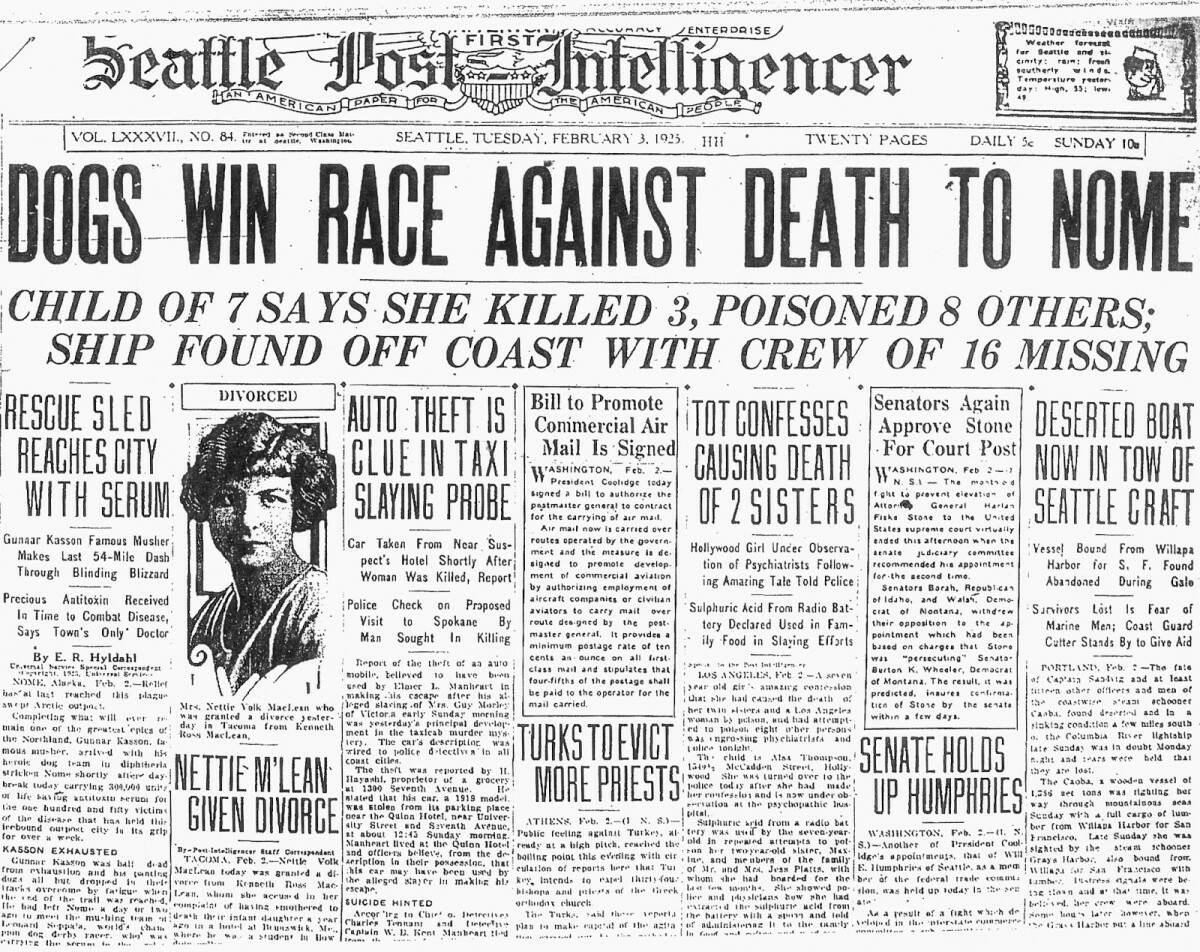It happened a hundred years ago. A relay-race of sled dog teams saved the lives of countless people in Nome, Alaska. In January 1925 an epidemic of diphtheria threatened the entire town. Because Nome did not have a sufficient amount of antitoxin, there was grave concern. Dr. Curtis Welch, the local physician, telegraphed Fairbanks, Anchorage, Seward and Juneau asking for help. The only serum that could be located in the entire state was at a hospital in Anchorage. Three hundred thousand units of serum would go a long way.
But how to get the life-saving medicine to Nome? Since the Bering Sea was frozen and there were no railroad tracks or roads that led to Nome, dog teams were the only solution. Scott Bone, Alaska’s territorial governor (who would later become editor of the Seattle Post-Intelligencer), authorized the time-sensitive operation.
The units of serum were packed in a cylinder and wrapped in fur and canvas. The precious cargo was transported from Anchorage to Nenana on an overnight train. The serum arrived at 11 p.m. on January 27. From there, it would need to be transported 674 miles by a sled dog relay in a race against time. It was a distance that mushers who delivered the mail normally covered in a month. But the dying children needed the antitoxin much sooner than that.
The first musher took the insulated cylinder 52 miles and passed it to the second musher who traveled 31 miles. From musher to musher, the relay continued involving a score of sled dog drivers and their teams. The needed medicine arrived in Nome on February 2, just 127 hours after the life-saving mission began. The cooperative effort of 20 mushers and 150 dogs that braved sub-zero temperatures and blinding blizzards accomplished the desired outcome. The lives of Nome’s children were saved.
That heroic adventure became known as the Serum Run of ’25. The Disney animated movie Balto is based on this real-life story that put Nome, that historic gold rush town, on the map once again. And the world-famous Iditarod Sled Dog Race that begins this week is an annual commemoration of that life-saving adventure that took place a century ago. On this milestone anniversary, I can’t help picturing how the arrival of the serum so long ago brought the community together much like the recent Bering Air crash united Nome as a family. In joy or in sorrow there’s no place like Nome.
As a pastor I see that miraculous mission of the Serum Run as an illustration of what Christians call the Gospel. Through Jesus’ incarnation birth and his atoning death on the cross, the seeming impossible challenge of saving our souls was accomplished once for all. Jesus traversed the unthinkable distance from His Father’s presence in Heaven to reach our defective planet with his life-saving blood. The essence of the Good News celebrates the serum of salvation, the only antidote for rescuing those who couldn’t save themselves.
Every Sunday Christians gather in worship to commemorate the life-saving rescue that achieved our salvation. But once a year Christians focus their reflection on the grueling cost associated with that redemptive accomplishment. That annual observance is known as Lent and allows Christ-followers to retrace his rescue mission.
Ironically this year’s Iditarod coincides with the beginning of Lent on the liturgical calendar. Ash Wednesday commences a six-week journey that finds some Christians fasting from favorite foods and other satisfying routines to identify with Jesus’ self-denying love. It is a self-imposed discipline to reach the destination of Good Friday and Easter Sunday with a heart of humility and gratitude. As with the Serum Run of ’25 and the Iditarod, Lent is a focused effort with a satisfying end. As the late-Eugene Peterson, a beloved ministry colleague once put it, it is “a long obedience in the same direction.”
Guest columnist Greg Asimakoupoulos is a former chaplain at Covenant Living at the Shores in Mercer Island.


